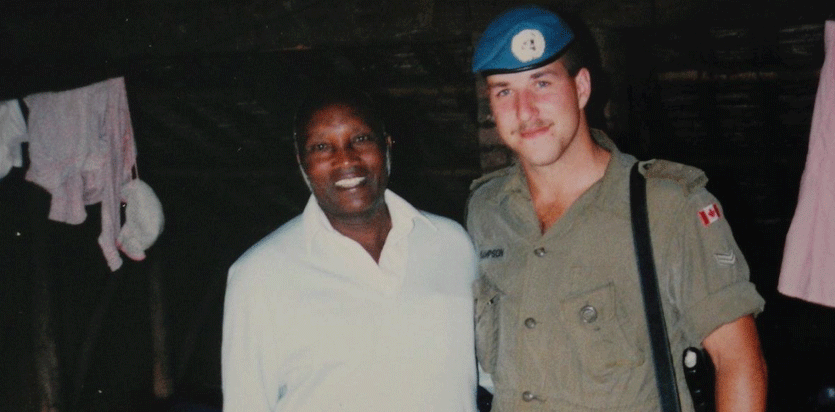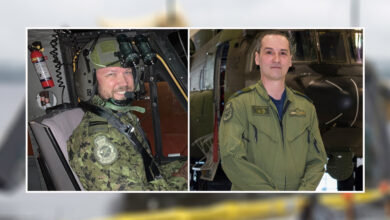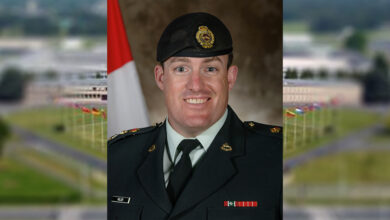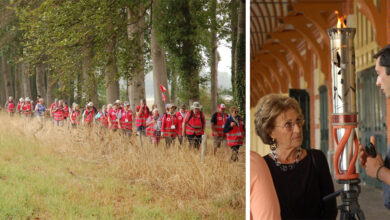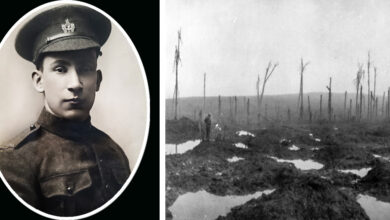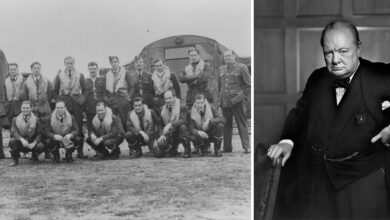Remembering
Rwandan Veteran finds hope after living through years of darkness
From 1993 to 1996, the rural African nation of Rwanda, about half the size of Nova Scotia, found itself in the wake of violent tensions that led to a grotesque genocide. In just a matter of three months, from April to July 1994, the country’s Hutu ethnic majority murdered close to one million members of the country’s Tutsi ethnic minority.
In July of 1994, roughly 300 members of the Signals Regiment from CFB Kingston were sent on Operation LANCE to reinforce Gen. Romeo Dallaire’s headquarters. These men and women spent up to seven months in the remotest parts of the country not only providing much-needed communications but helping the country to get back on its feet.
One of the 300 signallers deployed to Rwanda was WO (ret’d) Kevin “Sammy” Sampson.
In the middle of this devastating situation, Sampson and the five other Canadian signallers posted to the small Rwandan town of Gisenyi were able to find peace through the relationships they formed with Mrs. Rosamand Carr and 19 orphans. Mrs. Carr and the orphans of Imbabazi would forever change the lives of Sampson and his brothers-in-arms.
A humanitarian and author, Mrs. Carr was an 82-year old American woman and a close confidante and friend of the world-renowned animal activist Dian Fossey and had been portrayed in the 1988 film Gorillas in the Mist.
“When we walked in it was like opening the gardens of Eden. You just can’t imagine how it was like when you close her gate you’re in this spot where it’s the most peaceful thing you have seen,” recalled Sampson about visiting Mrs. Carr’s residence.
A few months into Sampson’s tour, Mrs. Carr shared her vision of opening an orphanage.
“She said there were all these children left over from the genocide, hundreds of them, and they have no families. We have to do something for them,” remembered Sampson.
Because of the admiration and love they had developed for this maternal figure, the soldiers were immediately on board to help. They helped to convert her drying house, a barn-like structure used to dry the plantation’s flowers, into the orphanage. They would do general repairs, pour cement and even, says Sampson, sneak out tables and blankets from UN headquarters to help set up the orphanage.
In a short period of time the Imbabazi Orphanage was ready.
One of the first orphans brought to Imbabazi was a four-year-old boy who had been found on the side of the road after his mother had died.
This little orphan boy immediately took to Sampson during their first meeting, vying for his attention.
“He’s pushing all the other kids away now. All the other kids want to hang out with the white guy because they don’t see white guys and definitely not white guys that are being nice to you with a machine gun and I am letting them jump over me. But he’s pushing them away like this white guy is mine,” laughed Sampson.
Not long after, Sampson was sent on a mission out of his sector to help deliver funds to the Rwandan government. After returning, he visited the orphanage and was informed that because of their attachment and the little boy’s admiration of him, Mrs. Carr had decided to name the boy after Sampson.
“He ran over to me and jumped up on me, and we were laughing, and Mrs. Carr said we’ve named him Sammy. We’ve given him the name Sammy because he’s big and strong and we want him to have your name. It took me surprise.”
Sammy would also often worry about Sampson if he hadn’t shown up for a few days.
“To this little four-year-old kid who had no connection with his life whatsoever, Sammy worried about me. He thought I was dead if I went away somewhere and didn’t make it, it was bizarre. And no matter what he knew there was a white guy out there from some UN country that loved him,” stated Sampson.
In early 1995, Sampson’s tour to Rwanda came to an end, and with that, he was forced to say goodbye to this little boy who had adopted his name and stolen a place in his heart.
“At the time when I left, I felt incredibly guilty. I had to walk away knowing people were still crossing the border and massacring people frequently,” said Sampson.
And so Sampson buried Mrs. Carr, Imbabazi, Rwanda, and Sammy deep within the confines of his mind, too afraid to look back.
Until earlier this year when Sampson reconnected with Sammy.
To read how WO Sampson’s story unfolds when he discovers his namesake survived, and how the mission affected WO Sampson life be sure to pick up a copy of our Spring 2018 issue at any of these retailers or subscribe to guarantee your copy.


